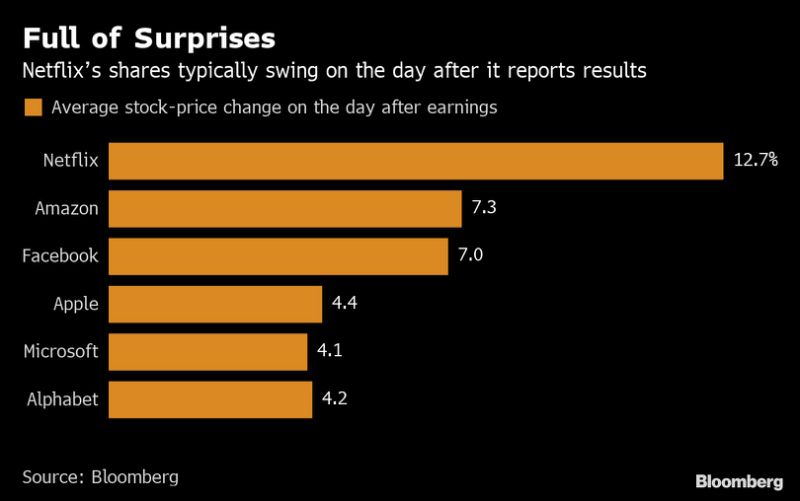(Bloomberg) — Netflix Inc.’s biggest earnings surprise in years sent the shares plummeting on Thursday. It also left analysts and investors wondering why they were caught so off guard.
When some companies know that their quarterly results are going to fall short of forecasts, they put out a pre-announcement or update their guidance. But not Netflix.
Instead, the company dropped a bombshell with no warning: Its customer growth was roughly half what it projected, and Netflix actually lost U.S. subscribers during the period. That hasn’t happened since 2011, when the company made a disastrous attempt to split up its streaming and DVD-by-mail operations.
The fallout on Thursday included the worst stock rout in three years, with the shares declining 10%. The plunge wiped out about $16 billion in market value.
“You would think Netflix would want to update guidance or give a pre-annoucement, as I’m sure they definitely knew about this for a while,” said Nick Licouris, an investment adviser at Gerber Kawasaki. “But they probably didn’t want to do it because they were going to take a hit at that time or during earnings — especially since subscriber numbers are the No. 1 thing analysts look at — and in earnings you can spin it better than a stand-alone announcement.”
Not Necessary?
Another reason not to issue a warning: The company met most of Wall Street’s financial estimates, such as sales and profit. It was only the subscriber numbers that really came up short.
“Revenue was very close to guidance and profits were actually above, so I’d guess they didn’t think it was necessary to pre-announce a weak sub number when other financial metrics were fine,” said Andy Hargreaves, an analyst at KeyBanc Capital Markets Inc.
There’s also been a broader shift away from giving earnings warnings, said Huber Research Partners founder Craig Huber.
“I have noticed companies in media and internet that I follow do not seem to pre-announce pending negative results with the same regularity as years ago,” he said.
Netflix, based in Los Gatos, California, didn’t have an immediate comment.
The streaming giant’s tight-lipped culture extends beyond earnings. Unlike traditional media companies, it’s very selective about the viewer information it provides. Third parties try to fill the gaps by providing their own data on Netflix’s audience, but that can be unreliable.
Third-Party Services
Those kinds of data services failed to predict the latest shortfall, Wolfe Research analyst Marci Ryvicker said in a note.
“For several days,” she said, “investors told us ‘such-and-such data service suggests domestic adds will come in line; while international might be somewhat soft.’ Wrong. I mean — right in the sense that international was soft but totally wrong on the domestic subs part.”
Netflix also delivers its earnings in an idiosyncratic way. Instead of doing a traditional Q&A conference call, the company releases an “earnings interview” on YouTube with a single analyst. It also issues its reports on its website, not through the paid services that many companies use to disseminate information.
Though this week’s stock rout was especially severe, it’s common for Netflix’s earnings to spark a huge share move. The average change on the day after quarterly reports is almost 13%, according to data compiled by Bloomberg. Compare that with Apple Inc., where it’s 4.4%. Or Microsoft Corp., where it’s 4.1%.
There’s another explanation for the huge swings in Netflix’s stock: overreaction. That was the message from Chief Executive Officer Reed Hastings this week. It’s easy to “overinterpret” subscriber figures, he said.
“Sometimes we are forecast high, sometimes we forecast low,” he said. “We’re just executing forward and trying to do the best forecast we can.”
–With assistance from Morwenna Coniam.
To contact the reporters on this story: Kamaron Leach in New York at [email protected];Lucas Shaw in Los Angeles at [email protected]
To contact the editors responsible for this story: Nick Turner at [email protected], Rob Golum
<p class="canvas-atom canvas-text Mb(1.0em) Mb(0)–sm Mt(0.8em)–sm" type="text" content="For more articles like this, please visit us at bloomberg.com” data-reactid=”63″>For more articles like this, please visit us at bloomberg.com
©2019 Bloomberg L.P.










